Where did banknotes come from?
The earliest banking involved money-changing between coin and bullion and between different currencies, issuing bills of exchange (in the form of a letter asking one person to pay a sum of money to another on behalf of the person who wrote the letter) and accepting deposit of valuables or money which earned interest. English bankers found they had a steady level of money deposited with them and used this to provide loans on which they then charged interest. About this time they allowed customers to transfer a credit amount to someone else by writing an order to the bank - the forerunner of the bank 'cheque'.
It was the bill of exchange which led to the issue of banknotes. On 27th July 1694 William Paterson, a Scottish merchant originally from Tinwald in Dumfries, obtained a Royal Charter from the king, William III, to form the the Bank of England in order to raise funds for the government of the day and started to issue banknotes. These were handwritten and made out to an individual who could cash them at any branch of the issuing bank. The Bank of England Act was passed which established the Bank of England as the world’s first national bank. Its first Governor was Sir John Houblon and the first Chief Cashier, briefly, was John Kendrick, about whom little is known. In 1697 the first watermark was introduced. From 1725 the notes were partially printed with just the name to whom payable, date, amount and cashier’s signature to be filled in by hand. Businessmen set up banks in London and 'provincial' banks as a way of raising capital for investment from the late eighteenth century. However by 1770 London banks had given up issuing their own notes and used the Bank of England banknotes instead.
The banknotes from 1725 were issued for amounts of £20, £25, £30 up to £100 in £10 stages, then £100 to £500 in £100 stages and lastly a £1000 note; in 1759 the first £10 and £15 notes appeared, in 1793 with economic difficulties due to the Napoleonic War a £5 note was introduced and in 1797 £2 and £1 notes. A total of 19 different notes! Worth noting that at this time £5 was more than the average working person earned in a year so rarely seen! The appearance of the low denomination notes meant that gradually more of the general public had to come to terms with paper money but banknotes were easy to counterfeit as many of their new owners were illiterate and not used to handling notes.
In 1833 Bank of England banknotes were made legal tender for all sums above £5 in England and Wales as a way of protecting the Bank’s bullion reserves in times of crisis. However most of the notes over £10 had disappeared by 1852, the £300 by 1893 and the £200 in 1918. This left just the £10, £20, £50, £100, £500 and £1000 which were withdrawn in 1943. The £10 reappeared in 1964, the £20 in 1970 and the £50 in 1981.
The big change came in 1855 when banknotes were fully printed including the chief cashier’s signature and had the words I promise to pay the bearer on demand the sum of .... People could use a banknote instead of coins and the system worked as long as people had confidence that the bank had the coin to redeem the note. In 1884 the Government decided to regulate the issue of banknotes by the Bank Charter Act and from then on the private provincial banks gradually merged until by 1921 the last provincial note had been issued. In 1914, the first issue Treasury notes, red 10 shillings and black £1, were signed by Sir John Bradbury and afterwards Sir Norman Fenwick Warren Fisher.
A Tale of Two Women
Up to 1928 banknotes were ‘white’ notes printed in black on white paper and unprinted on the back. However on 22nd November the Bank of England took over the issue of banknotes from the Treasury and produced full colour 10/- and £1 notes printed on both sides. This first series is called ![]() Britannia Series A as they featured a rather demure seated Britannia with curiously a spear and an olive branch possibly offering a choice of peace or war. The bee skep beside her may symbolise the bank as a store of the nation's riches or the industry of the bank in looking after the nation’s money. The idea of dressing Britannia as a noble Saxon lady came from Daniel Maclise, RA, in 1855 who used his daughter as the model. The ornamental clasp on her cape indicates a rank of nobility.
Britannia Series A as they featured a rather demure seated Britannia with curiously a spear and an olive branch possibly offering a choice of peace or war. The bee skep beside her may symbolise the bank as a store of the nation's riches or the industry of the bank in looking after the nation’s money. The idea of dressing Britannia as a noble Saxon lady came from Daniel Maclise, RA, in 1855 who used his daughter as the model. The ornamental clasp on her cape indicates a rank of nobility.
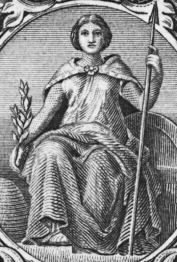
They were issued up to the early 1960's by four Chief Cashiers, Basil Catterns (19th Chief Cashier) 29-34, Kenneth Peppiatt 34-49, Percival Beale 49-55 and Leslie O’Brien 55-62. During the period from 1926 on the Bank of England set up 14 branches around the country which issued banknotes. However most ended by 1938, only Swansea continued until 1959 and Leicester issued notes from 1944 to 1972.
During the Second World War Germany produced some excellent forgeries so in 1940 the color of the Peppiatt 10/- note was altered to mauve and the £1 to blue. The regular colours returned after the war.
In February 1957 the white £5 was finally replaced by a curious single note
series known as ![]() Helmeted Britannia Series B.
These were only issued under L.K.O’Brien and feature this lovely portrait. The artist
Richard Horsman Solly created the first helmeted Britannia
in 1818 as a proposal for a new series of “inimitable” one pound notes. The image was never used but artist Stephen
Gooden recalled it almost exactly for the Britannia used on this blue five-pound note. On the reverse is a superb lion carrying
a key.
Helmeted Britannia Series B.
These were only issued under L.K.O’Brien and feature this lovely portrait. The artist
Richard Horsman Solly created the first helmeted Britannia
in 1818 as a proposal for a new series of “inimitable” one pound notes. The image was never used but artist Stephen
Gooden recalled it almost exactly for the Britannia used on this blue five-pound note. On the reverse is a superb lion carrying
a key.
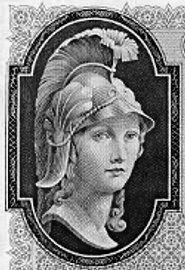
This note only lasted until 1964 when the Queen had given her permission to include her portrait on banknotes and the ![]() Portrait Series C appeared with a portrait designed by Robert Austin, Professor of Engraving at the Royal College of Art.
Portrait Series C appeared with a portrait designed by Robert Austin, Professor of Engraving at the Royal College of Art.
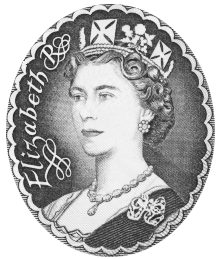
The 10/- note was issued from 1963, the £1 from 1960, the £5 from 1963 and the £10 from 1964 by four Chief Cashiers, Leslie O’Brien, Jasper Hollom 62-66, John Fforde 66-70 and John Page 70-80.
On the Jasper Hollom £5 and £10 notes, the Queen has turned to look at us and a rather sad Britannia on the reverse of the £5 has found a shield and a pile of boulders. On the reverse of the £10, a rather odd lion holds the key.

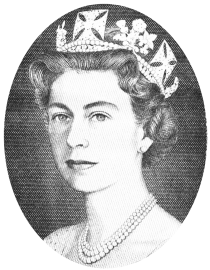
Ten years later the next series began to appear - the ![]() Pictorial Series D with a gentler portrait of the Queen and full-length pictures of English notables on the reverse. The John Fforde 10 shilling note had been replaced by the 50p coin in 1968 and so the smallest denomination from then on was the £1 note.
Pictorial Series D with a gentler portrait of the Queen and full-length pictures of English notables on the reverse. The John Fforde 10 shilling note had been replaced by the 50p coin in 1968 and so the smallest denomination from then on was the £1 note.
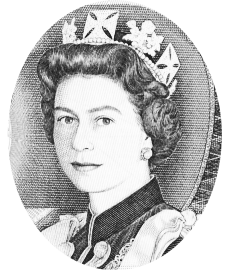
The notes featured:
£1 - Sir Isaac Newton £5 - Duke of Wellington £10 - Florence Nightingale
£20 - William Shakespeare £50 - Sir Christopher Wren
The £1 note was issued from 1978, the £5 from 1971, the £10 from 1975, the £20 from 1970 and the £50 from 1981. The Chief Cashiers who issued them were John Fforde, John Page, David Somerset 80-88, Malcolm Gill 88-91 and Graham Kentfield 91-98. With devaluation over the years, the £1 note was replaced by a coin in 1983 and the last £1 note was issued by David Somerset in 1985. It went out of circulation in 1988.
The next major series came in 1990 with ![]() Historical Series E. A more mature Queen's portrait by artist Harry Eccleston and portraits of famous people and appropriate scenes on the reverse. Incidentally this series was the first to include a copyright notice although it always was, and is, a criminal offence to forge banknotes so what its purpose is remains obscure.
Historical Series E. A more mature Queen's portrait by artist Harry Eccleston and portraits of famous people and appropriate scenes on the reverse. Incidentally this series was the first to include a copyright notice although it always was, and is, a criminal offence to forge banknotes so what its purpose is remains obscure.
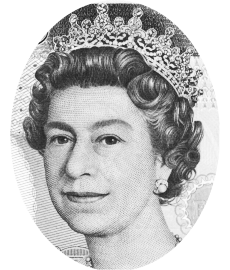
The notes featured:
£5 - George Stephenson and the Rocket locomotive £10 - Charles Dickens and The Pickwick Papers
£20 - Michael Faraday and the Christmas Lectures £50 - Sir John Houblon and his house in Threadneedle Street.
The green £5 note was issued from June 1990, the £10 from April 1992, the £20 from June 1991 (all revised in 1993 to aid the partially sighted) and the £50 from April 1994. The three Chief Cashiers who issued this series were Malcolm Gill, Graham Kentfield and Merlyn Lowther 99-03, who was the first female Chief Cashier.
Finally ![]() New (Revised) Series E £5 - Elizabeth Fry, showing a scene with her reading to prisoners in Newgate Prison £10 - Charles Darwin, a hummingbird and the HMS Beagle £20 - Sir Edward Elgar with a view of the west face of Worcester Cathedral. The £5 was issued from May 2002, the £10 from November 2000 and the £20 from June 1999. This replacement series was issued by Merlyn Lowther.
New (Revised) Series E £5 - Elizabeth Fry, showing a scene with her reading to prisoners in Newgate Prison £10 - Charles Darwin, a hummingbird and the HMS Beagle £20 - Sir Edward Elgar with a view of the west face of Worcester Cathedral. The £5 was issued from May 2002, the £10 from November 2000 and the £20 from June 1999. This replacement series was issued by Merlyn Lowther.
In March 2007 the first note from the ![]() New Series F entered circulation. £20 - Adam Smith, with an illustration of ‘The division of labour in pin manufacturing’, replaced the Series E Elgar note. It was issued by Andrew Bailey, the 30th Chief Cashier of the Bank of England. Sadly Britannia is now relegated to a very minor role and, only 7mm tall she is tucked away in a corner with her rocks, branch, spear and shield.
New Series F entered circulation. £20 - Adam Smith, with an illustration of ‘The division of labour in pin manufacturing’, replaced the Series E Elgar note. It was issued by Andrew Bailey, the 30th Chief Cashier of the Bank of England. Sadly Britannia is now relegated to a very minor role and, only 7mm tall she is tucked away in a corner with her rocks, branch, spear and shield.

Paper and Printing
The paper used has always been chosen so as to give a distinct look and feel.
It is 80 to 90 gsm paper manufactured from cotton fibre sometimes mixed with linen and is impregnated with polyvinyl alcohol or
gelatin to give it extra strength. One of the first papermakers was the firm started by a Huguenot, Henri de Portal, in 1712 at
Bere Mill and in 1718 at Laverstoke Mill both on the
river Test near Overton in Hampshire and carried on by his son Joseph Portal who bought Laverstoke Manor. They produced paper
for Bank of England notes from 1724. They also invented the metallic thread incorporated into the paper which started off within
the paper and latterly is allowed to come to the surface as a dotted line called ‘windowed thread’.
Printing is a combination of three processes — Offset Lithography for the
background tints and fine lines; Intaglio Printing gives the stronger coloured fine detail with slightly raised print and also never
completely dries which is a useful security test; Letterpress is used for serial numbers.
Some printing changes have been marked on the reverse of the banknotes. In 1973
the Somerset £1 note was printed on a new web press and a little W appears; the £5 was also
moved to a web press with offset lithography on the reverse, marked L; the 1984 £10 note on a web
press was also marked W on the reverse.
The latest security features to make life difficult for forgers include:
holograms, fluorescent features, varnish coating, foil impression, windowed metallic thread and extremely fine print.
POSTSCRIPT: Numismatics is the study of money, particularly coins, and a numismatist is a collector. However
Notaphily is the study of paper money or banknotes and a notaphilist is a collector of such (according to Wikipedia).
More about English coins.
Sources:
UCLE: Articles - http://alt-usage-english.org/ucle/ucle8.html - the Britannia imagesRoyal Philatelic Society- http://www.rpsl.org.uk/treasury_notes/index.html